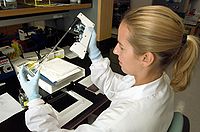
Pulsed field gel electrophoresis
Encyclopedia
Pulsed field gel electrophoresis is a technique used for the separation of large deoxyribonucleic acid
(DNA) molecule
s by applying an electric field that periodically changes direction to a gel matrix.

techniques for separation of DNA molecules provided huge advantages for molecular biology research. However, many limitations existed with the standard protocol in that it was unable to separate very large molecules of DNA effectively. DNA molecules larger than 15-20kb migrating through a gel will essentially move together in a size-independent manner. At Columbia University in 1984, Schwartz and Cantor
developed a variation on the standard protocol by introducing an alternating voltage gradient to better the resolution of larger molecules. This technique became known as Pulsed Field Gel Electrophoresis (PFGE). The development of PFGE expanded the range of resolution for DNA fragments by as much as 2 orders of magnitude.
This procedure takes longer than normal gel electrophoresis due to the size of the fragments being resolved and the fact that the DNA does not move in a straight line through the gel.
DNA
Deoxyribonucleic acid is a nucleic acid that contains the genetic instructions used in the development and functioning of all known living organisms . The DNA segments that carry this genetic information are called genes, but other DNA sequences have structural purposes, or are involved in...
(DNA) molecule
Molecule
A molecule is an electrically neutral group of at least two atoms held together by covalent chemical bonds. Molecules are distinguished from ions by their electrical charge...
s by applying an electric field that periodically changes direction to a gel matrix.

Historical background
Standard gel electrophoresisDNA electrophoresis
Nucleic acid electrophoresis is an analytical technique used to separate DNA or RNA fragments by size and reactivity. Nucleic acid molecules which are to be analyzed are set upon a viscous medium, the gel, where an electric field induces the nucleic acids to migrate toward the anode, due to the net...
techniques for separation of DNA molecules provided huge advantages for molecular biology research. However, many limitations existed with the standard protocol in that it was unable to separate very large molecules of DNA effectively. DNA molecules larger than 15-20kb migrating through a gel will essentially move together in a size-independent manner. At Columbia University in 1984, Schwartz and Cantor
Charles Cantor
Charles Cantor is an American molecular geneticist who, in conjunction with David Schwartz, developed pulse field gel electrophoresis for very large DNA molecules....
developed a variation on the standard protocol by introducing an alternating voltage gradient to better the resolution of larger molecules. This technique became known as Pulsed Field Gel Electrophoresis (PFGE). The development of PFGE expanded the range of resolution for DNA fragments by as much as 2 orders of magnitude.
Procedure
The procedure for this technique is relatively similar to performing a standard gel electrophoresis except that instead of constantly running the voltage in one direction, the voltage is periodically switched among three directions; one that runs through the central axis of the gel and two that run at an angle of 120 degrees either side. The pulse times are equal for each direction resulting in a net forward migration of the DNA. For extremely large bands (up to around 2Mb), switching-interval ramps can be used that increases the pulse time for each direction over the course of a number of hours—take, for instance, increasing the pulse linearly from 10 seconds at 0 hours to 60 seconds at 18 hours.This procedure takes longer than normal gel electrophoresis due to the size of the fragments being resolved and the fact that the DNA does not move in a straight line through the gel.

